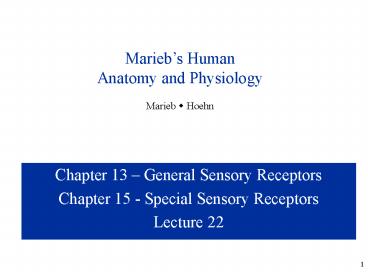Bio211 Lecture 22 - PowerPoint PPT Presentation
Title:
Bio211 Lecture 22
Description:
Anatomy and Physiology Marieb w Hoehn ... on upper surface of basilar membrane different frequencies of vibration move different parts of basilar membrane ... – PowerPoint PPT presentation
Number of Views:152
Avg rating:3.0/5.0
Title: Bio211 Lecture 22
1
Mariebs Human Anatomy and Physiology Marieb w
Hoehn
Chapter 13 General Sensory Receptors Chapter 15
- Special Sensory Receptors Lecture 22
2
Lecture Overview
- Introduction to the senses and sensation
- Types of sensors
- Classification of sensory receptors
- Anatomy of the ear
- Physiology of hearing/equilibrium
- Anatomy of the eye
- Physiology of vision
Video 1
Video 2
Video 3
3
Special Senses
- sensory receptors are within large, complex
sensory organs in the head - hearing and equilibrium in ears
- sight in eyes
- smell in olfactory organs
- taste (gustation) in taste buds
(Video 2)
(Video 3)
Not covered in video see master slide set
4
Overview of the Ear
5
External Ear
- auricle (pinna)
- collects sounds waves
- external auditory meatus
- lined with ceruminous glands
- carries sound to tympanic membrane
- terminates at tympanic membrane
- tympanic membrane
- vibrates in response to sound waves
6
The Middle Ear (Tympanic Cavity)
Typanic (attenuation) reflex Elicited about 0.1
sec following loud noise causes contraction of
the tensor tympani m. and stapedius m. to dampen
transmission of sound waves
7
Auditory Tube
- Eustachian, auditory, or pharyngotympanic tube
- connects middle ear to throat
- helps maintain equal pressure on both sides of
tympanic membrane - usually closed by valve-like flaps in throat
When pressure in tympanic cavity is higher than
in nasopharynx, tube opens automatically. But
the converse is not true, and the tube must be
forced open (swallowing, yawning, chewing).
8
Inner Ear
- 3 Parts of Labyrinth
- cochlea
- functions in hearing
- semicircular canals
- function in equilibrium
- vestibule
- functions in equilibrium
- utricle and saccule
Labyrinth
9
Cochlea
Cochlea as it would look unwound
- Scala tympani
- lower compartment
- extends from apex of the cochlea to round window
- part of bony labyrinth
Scala vestibuli upper compartment leads from
oval window to apex of spiral part of bony
labyrinth
10
Organ of Corti
- group of hearing receptor cells (hair cells)
- on upper surface of basilar membrane
- different frequencies of vibration move
different parts of basilar membrane - particular sound frequencies cause hairs
(stereocilia) of receptor cells to bend - nerve impulse generated
11
Physiology of Hearing
Figure from Marieb, Human Anatomy Physiology,
Pearson, 2013
Know pathway for exam
Tympanic membrane ? malleus ? incus ? stapes ?
oval window ? scala vestibuli ? scala tympani ?
round window
12
Auditory Nerve Pathways
Accessory Nerve (CN XI)
Figure from Martini, Fundamentals of Anatomy
Physiology, Pearson Education, 2004
(pons)
13
Vestibule
- Utricle
- communicates with saccule and membranous portion
of semicircular canals - Saccule
- communicates with cochlear duct
- Macula
- contains hair cells of utricle (horizontal) and
saccule (vertical)
Utricle and saccule provide sensations of 1)
gravity and 2) linear acceleration
These organs function in static equilibrium
(head/body are still)
14
Macula
- responds to changes in head position
- bending of hairs results in generation of nerve
impulse
15
Semicircular Canals
- three canals at right angles
- ampulla (expansion)
- swelling of membranous labyrinth that
communicates with the vestibule - crista ampullaris
- sensory organ of ampulla
- hair cells and supporting cells
- rapid turns of head or body stimulate hair cells
Acceleration of fluid inside canals causes nerve
impulse
These organs function in dynamic equilibrium
(head/body are in motion)
16
Crista Ampullaris
Semicircular canals respond to rotational,
nonlinear movements of the head
17
Pathways for Equilibrium Sensations
For vestibulo-ocular reflex
Figure from Martini, Fundamentals of Anatomy
Physiology, Benjamin Cummings, 2004
18
Please Take the Short Quiz
Remember to take the brief quiz now to see if
youve gotten the major concepts from the
video. You can always go back and review the
video as many times as you like and can retake
the quiz, as well.































